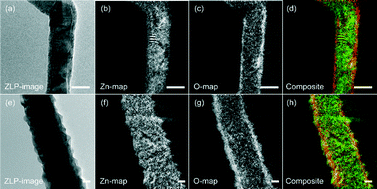Metal–semiconductor Zn/ZnO core–shell nanocables: facile and large-scale fabrication, growth mechanism, oxidation behavior, and microwave absorption performance
Abstract
A new and facile synthetic route has been developed for the fabrication of metal–semiconductor Zn/ZnO core–shell nanocables on a large scale. Zn/ZnO nanocables were grown by heating a ball-milled mixture of boron and ZnO powders at 1300 °C under ammonia atmosphere. The structure and chemical composition of the as-prepared products were characterized by a variety of techniques including powder X-ray diffraction, scanning electron microscopy, high-resolution transmission electron microscopy, and X-ray photoelectron spectroscopy. The nanocables were approximately 30–200 nm in diameter and tens of microns in length. The core was a Zn single crystal and the shell was an epitaxially grown ZnO layer of 3–10 nm thickness. It was found that the Zn/ZnO nanocables transformed into mace-like nanostructures or ZnO nanotubes when oxidized at 300 °C in air. The formation mechanism of the Zn/ZnO nanocables as well as the oxidized products has been clarified based on the experimental observations. The Zn/ZnO nanocable–paraffin composites showed good microwave absorption properties, and the reflection loss could reach −23 dB at 13.22 GHz. The mechanism for the enhanced absorption performance is discussed.


 Please wait while we load your content...
Please wait while we load your content...